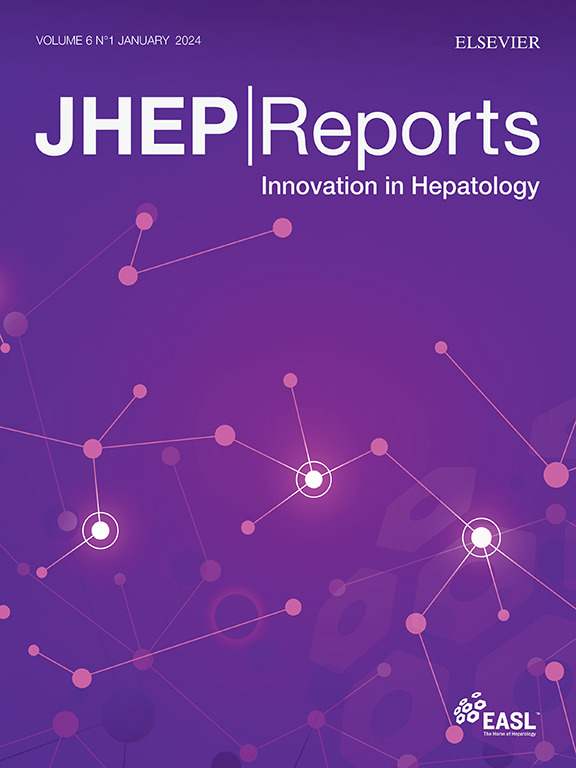Macrophage ATG16L1 promotes liver regeneration after partial hepatectomy
IF 9.5
1区 医学
Q1 GASTROENTEROLOGY & HEPATOLOGY
引用次数: 0
Abstract
Background & Aims
Autophagy plays an important role in liver regeneration. However, most studies are limited to hepatocytes, and the function and mechanism of macrophage autophagy in liver regeneration remain unclear. This study investigated the role of the essential autophagy gene encoding autophagy-related 16-like 1 (ATG16L1), which regulates the macrophage phenotype in liver regeneration.
Methods
We generated FloxP-Atg16l1 (Atg16l1FL/FL), Lyz2-Cre Atg16l1 knockout (KO) (Atg16l1M-KO), and myeloid-specific Atg16l1-overexpression-knock-in (Atg16l1OE) mice. These mice were subjected to 70% partial hepatectomy to demonstrate the role of ATG16L1 in macrophages during liver regeneration.
Results
ATG16L1 expression was significantly upregulated in macrophages during the early stages of liver regeneration. ATG16L1 deletion in macrophages substantially delayed liver regeneration in mice and caused a marked imbalance in Ly6Chi and Ly6Clo macrophage proportions in the liver. RNA-sequencing analysis revealed that, compared with macrophages isolated from Atg16l1FL/FL mice, those from Atg16l1M-KO mice exhibited significant downregulation of genes associated with oxidative phosphorylation and upregulation of proinflammatory gene expression. Mechanistically, ATG16L1 loss impaired mitophagy in macrophages, leading to the accumulation of mitochondrial damage and a metabolic shift that promoted proinflammatory macrophage polarization. ATG16L1 deficiency not only promoted macrophage mitochondrial (mt)DNA release and cyclic GMP-AMP synthase–stimulator of interferon genes (STING) activation, but also suppressed STING degradation. Sustained STING hyperactivation and subsequent increased release of downstream interferons further contributed to the inhibition of liver regeneration. Notably, pharmacological activation or genetic overexpression of ATG16L1 significantly enhanced liver regeneration in mice.
Conclusions
ATG16L1 has a pivotal role in liver regeneration by affecting the phenotype and function of macrophages. Thus, targeting ATG16L1 in macrophages could present a novel strategy for promoting liver regeneration.
Impact and implications
The autophagy-related gene ATG16L1 mediates mitophagy, facilitating the clearance of damaged mitochondria in macrophages following partial hepatectomy and maintaining a reparative macrophage phenotype. ATG16L1 deficiency triggers excessive STING activation and inhibits its degradation, thereby suppressing liver regeneration. Thus, targeting ATG16L1 in macrophages could represent a novel strategy to promote liver regeneration.

巨噬细胞ATG16L1促进肝部分切除术后肝脏再生
背景,aimself - hagy在肝脏再生中起重要作用。然而,大多数研究仅限于肝细胞,巨噬细胞自噬在肝再生中的功能和机制尚不清楚。本研究探讨了自噬必需基因编码自噬相关16-like 1 (ATG16L1)在肝脏再生中调控巨噬细胞表型的作用。方法制备FloxP-Atg16l1 (Atg16l1FL/FL)、Lyz2-Cre Atg16l1敲除(KO) (atg16lm1 -KO)和骨髓特异性Atg16l1过表达敲除(Atg16l1OE)小鼠。这些小鼠接受70%的部分肝切除术,以证明ATG16L1在肝再生过程中对巨噬细胞的作用。结果肝再生早期巨噬细胞中satg16l1表达显著上调。巨噬细胞中ATG16L1的缺失严重延迟了小鼠肝脏再生,并导致肝脏中Ly6Chi和Ly6Clo巨噬细胞比例明显失衡。rna测序分析显示,与Atg16l1FL/FL小鼠分离的巨噬细胞相比,Atg16l1M-KO小鼠分离的巨噬细胞表现出氧化磷酸化相关基因的显著下调和促炎基因表达的上调。在机制上,ATG16L1缺失损害了巨噬细胞的线粒体自噬,导致线粒体损伤的积累和促进促炎巨噬细胞极化的代谢转变。ATG16L1缺失不仅促进巨噬细胞线粒体(mt)DNA的释放和环GMP-AMP合成酶刺激干扰素基因(STING)的激活,而且抑制STING的降解。持续的STING过度激活和随后的下游干扰素释放增加进一步抑制了肝脏再生。值得注意的是,ATG16L1的药理激活或基因过表达显著增强了小鼠的肝脏再生。结论satg16l1通过影响巨噬细胞的表型和功能,在肝脏再生中起关键作用。因此,靶向巨噬细胞中的ATG16L1可能是一种促进肝脏再生的新策略。影响和意义自噬相关基因ATG16L1介导线粒体自噬,促进部分肝切除术后巨噬细胞中受损线粒体的清除,并维持巨噬细胞的修复表型。ATG16L1缺乏会导致STING过度激活,抑制其降解,从而抑制肝脏再生。因此,靶向巨噬细胞中的ATG16L1可能是一种促进肝脏再生的新策略。
本文章由计算机程序翻译,如有差异,请以英文原文为准。
求助全文
约1分钟内获得全文
求助全文
来源期刊

JHEP Reports
GASTROENTEROLOGY & HEPATOLOGY-
CiteScore
12.40
自引率
2.40%
发文量
161
审稿时长
36 days
期刊介绍:
JHEP Reports is an open access journal that is affiliated with the European Association for the Study of the Liver (EASL). It serves as a companion journal to the highly respected Journal of Hepatology.
The primary objective of JHEP Reports is to publish original papers and reviews that contribute to the advancement of knowledge in the field of liver diseases. The journal covers a wide range of topics, including basic, translational, and clinical research. It also focuses on global issues in hepatology, with particular emphasis on areas such as clinical trials, novel diagnostics, precision medicine and therapeutics, cancer research, cellular and molecular studies, artificial intelligence, microbiome research, epidemiology, and cutting-edge technologies.
In summary, JHEP Reports is dedicated to promoting scientific discoveries and innovations in liver diseases through the publication of high-quality research papers and reviews covering various aspects of hepatology.
 求助内容:
求助内容: 应助结果提醒方式:
应助结果提醒方式:


